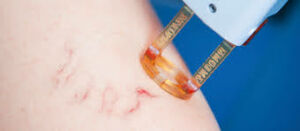Laser/light therapy is a non-toxic and non-invasive therapy that uses light energy to destroy unwanted cells and veins.
What you should know about laser/light therapy for spider veins
During laser/light therapy, a laser is applied to the spider veins. The laser transmits photons that are absorbed by the blood cells in the veins, which generates heat that destroys the blood vessel. The damaged vein shrinks and eventually dissolves over time.
Possible risks
AAs with any treatment, there are risks associate with it, though they are minimized in the hands of a qualified ASDS dermatologist. These include:
- Pain
- Swelling
- Discoloration
- Bleeding
- Infection
- Scarring
- Crusting
Why choose laser/light therapy for spider veins
Laser/light therapy is considered the treatment of choice for facial spider veins. It can be used on other parts of the body as well. Only rarely is laser/light therapy used on leg veins.
What to expect after the procedure
Patients may not see any significant changes until several weeks after the surgery. Multiple treatments may be required. Other post-procedure issues include:
- Treated area may be pink or red for four to eight hours after treatment.
- A slight stinging sensation, similar to a mild sunburn in the treated area. This sensation usually subsides within four to six hours. Cool packs or moist cloths may be applied to reduce the sensation.
- Mild swelling in the treatment area that usually dissipates within several days.
In addition, patients should:
- Avoid applying makeup or lotion to the treated area for either 24 hours or until all signs of redness and stinging have dissipated.
- Apply a good moisturizing lotion to the treated area twice daily for the duration of the treatments and for at least three months after final treatment.
How to prepare for the procedure
Before the procedure, an ASDS dermatologist will usually review the patient’s medical history and conduct a physical exam. This is the time for the doctor and patient to discuss expectations, potential risks and outcomes of the procedure. Patients also should:
- Avoid sunbathing, tanning beds or waxing for two weeks prior to the procedure.
- Avoid aspirin, anti-inflammatory drugs and herbal supplements due to increased risk of bleeding.

